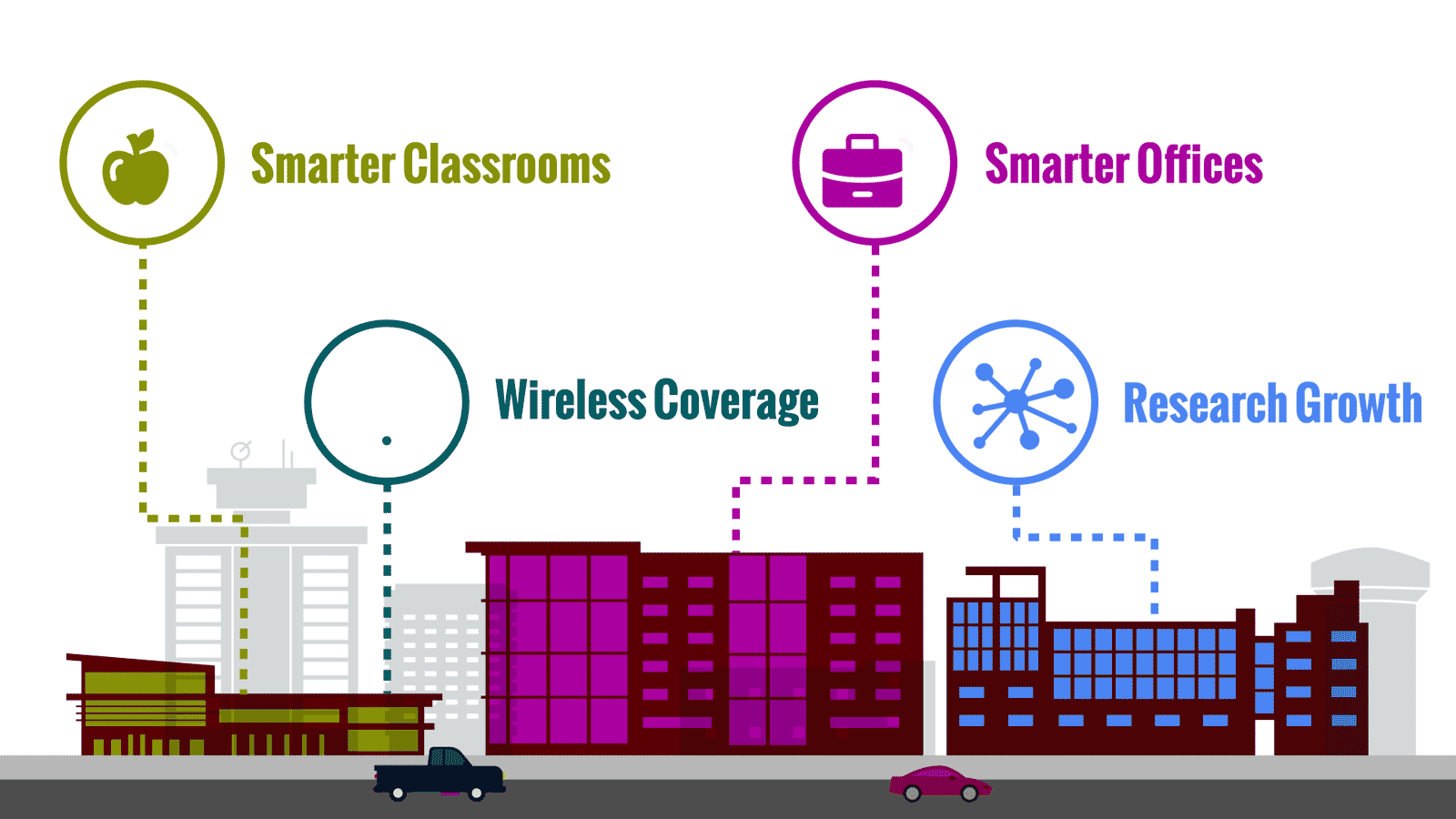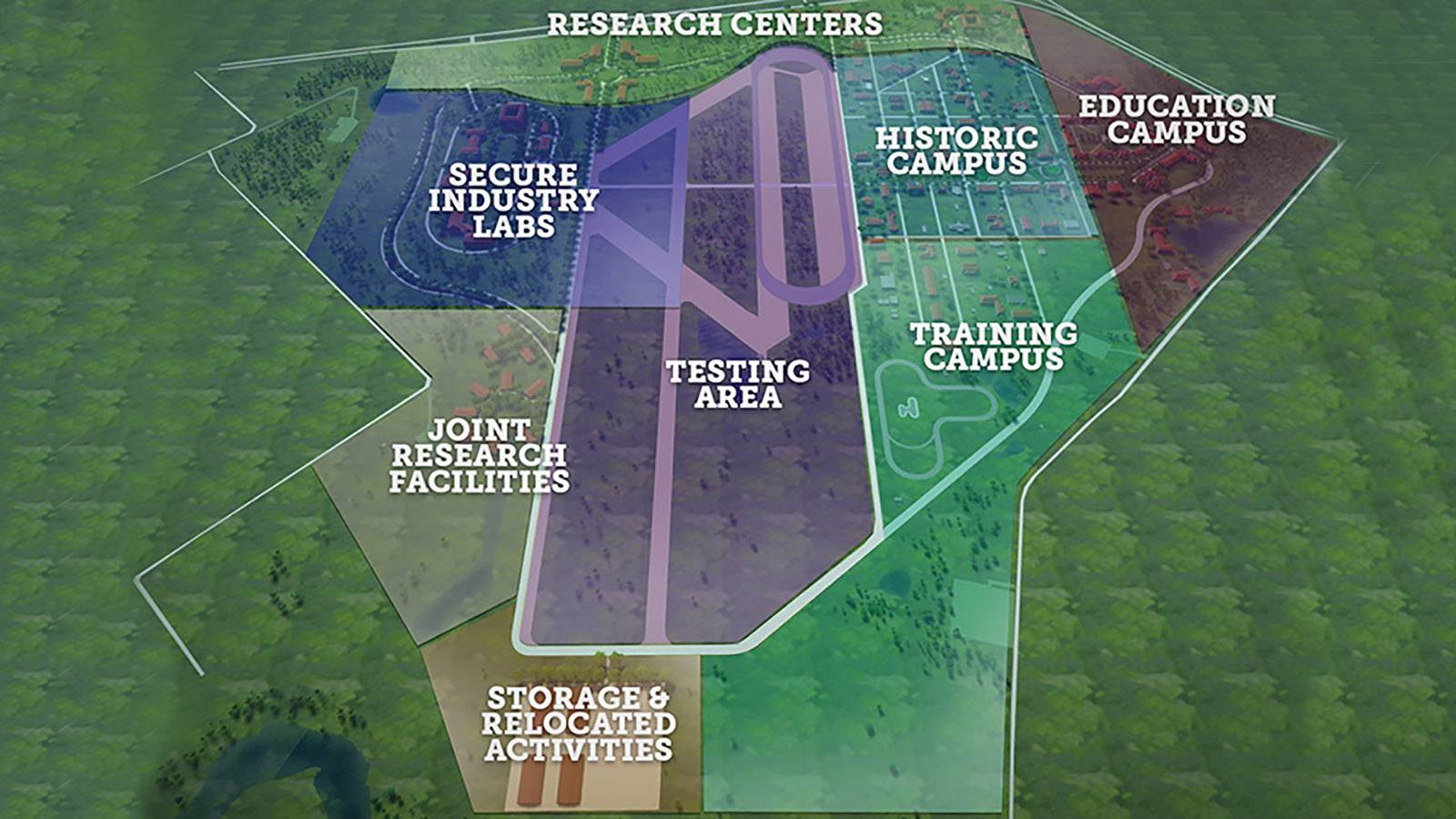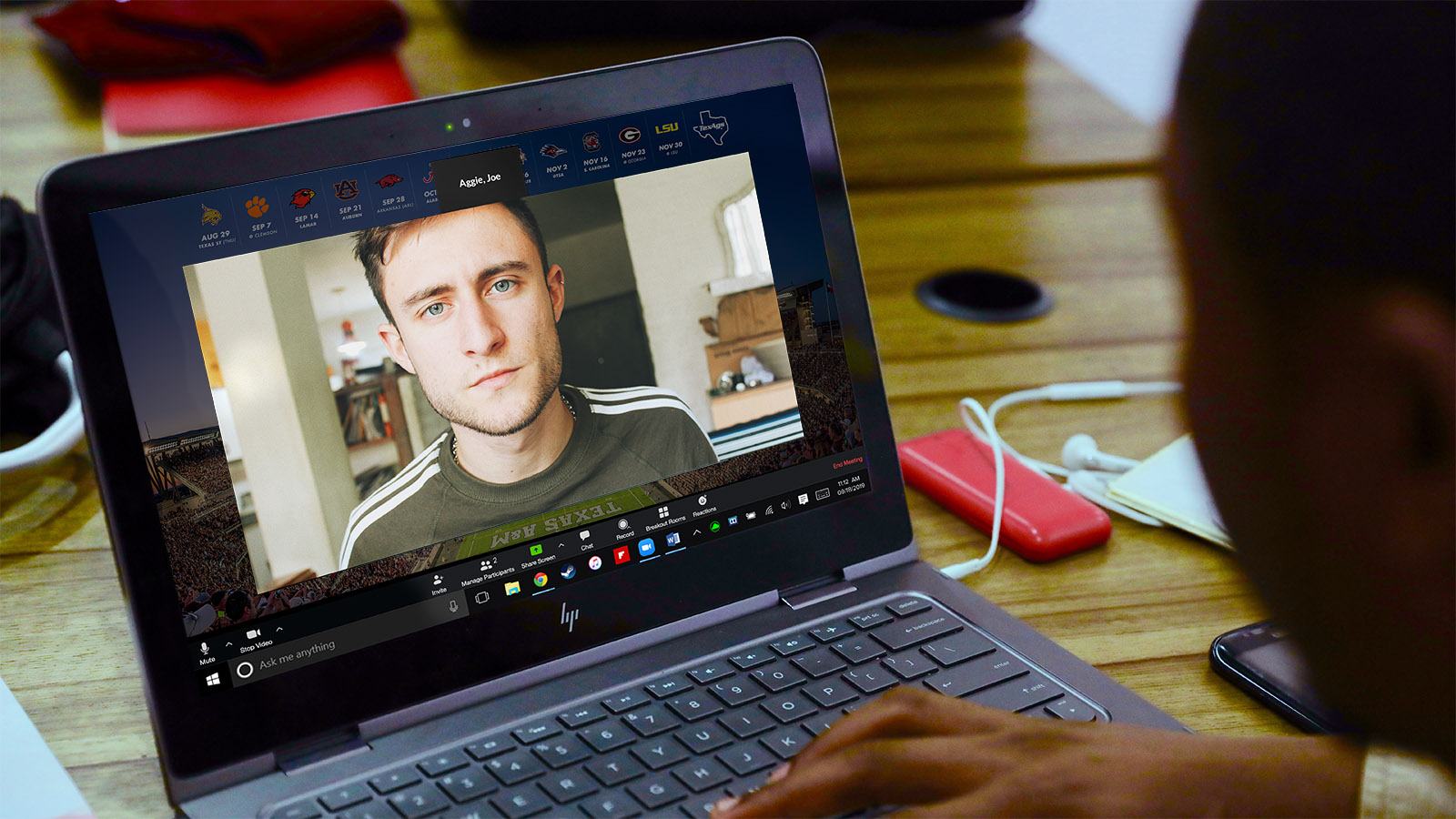Innovation
Plans Underway for Next Generation Aggie Network
Broadly defined, a network is an interconnected system allowing collaboration and communication. When it comes to Texas A&M University, we exemplify the saying “everything is bigger in Texas” with one of the largest campus research and education data networks in the country.
A secure, robust and reliable network is integral to the university’s success. As technology becomes more pervasive, demand for greater and more advanced network capabilities is skyrocketing. In addition, university growth in just the last ten years has increased network demand exponentially, with a 40% increase in student enrollment and over four million new square feet of construction. In order to keep pace, the Division must plan for a Next Generation Aggie Network.

- Data-driven science generating large amounts of data researchers need to gather and share with collaborators.
- Advanced lab equipment allows large amounts of data to be gathered, transmitted and stored, such as 3D imagery.
- Participation in global internet alliances ensures researchers have access to advanced technology, making them competitive for research grants.
- Voice over IP (VOIP) uses the network for transmission and has nearly replaced telephone service.
- Campus offices rely on numerous wireless printers.
- Video conferencing utilized for meetings.
- Video, collaboration technology and easy access to online resources integral to 21st century classroom.
- Online learning management systems growing in adoption.
- Students using more online textbooks.
- Ability to transmit data built into almost everything electronic, from smartwatches and laptops to vending machines.
- Campus community members carry an average of 3-4 devices simultaneously connected to wireless network.
- Approximately 85% of campus indoor spaces and 60% of outdoor spaces have wireless coverage.
“The project is in the early development phases, and will be a major undertaking,” said Sean Michaelson, network architect for the Division of IT. “Our network contains approximately 7,000 individual switches or hardware connections spread across 600 buildings on main campus. The network connects over 180,000 wired devices and sees over 110,000 unique Wi-Fi users daily.”
For almost three decades, equipment has been added and upgraded on an incremental basis. The current network has an approximate valuation of $55-$60 million. The first step of the next-generation network is replacing legacy equipment which could cost approximately $20-$25 million. The next phase will include laying the foundation upon which the new network could be built. Efforts are underway to examine the historical and current models used to fund the network and its operations, and determine the best strategy to ensure the network can meet the current and future needs of the campus for years to come.
"While we’re trying to create an environment that runs faster and is more flexible for individual users, we have to make sure everything remains secure."
A three-year project was launched in FY19 to upgrade the core campus fiber plant and allow the network to support a minimum of 10 gigabit connections for all main campus buildings. Phases one and two included 44 buildings and is 75% complete. A funding request is currently pending for phase three, which will upgrade 34 additional buildings.
“We are moving towards a modular framework that would allow different service regions to be upgraded independent of the entire campus,” Michaelson said. “So as different pockets start growing, we can keep pace with evolving technologies in the industry.”
Michaelson said another objective of the project will be centralized authentication allowing users to have the same permissions across campus and not just when geographically located close to the network equipment. This is imperative, he said, since “the campus is now the classroom.” As the network evolves, however, Michaelson says security will always be a top priority.
“While we’re trying to create an environment that runs faster and is more flexible for individual users, we have to make sure everything remains secure,” Michaelson stressed. “We run the full gamut of research and those results are precious assets, just like student records, HIPAA records and other information. So we need to ensure that while we’re protecting the individual students and employees, we are protecting our researchers and their findings as well.”
New Technology Calls for Testing Facility at RELLIS
Texas A&M University is joining forces with the US Army Futures Command to research technologies that will modernize the nation’s armed forces — and possibly change life as we know it — thanks to the focus on fifth generation (5G) wireless technology.
A $130 million combat development complex will be constructed at the RELLIS campus. The complex is funded by a $50 million appropriation from the Texas Legislature for an “Innovative Proving Ground” and $80 million from The Texas A&M University System Board of Regents for a “Research Innovation Center.” Recently, the U.S. Army Futures Command and TAMUS entered into a $65 million cooperative agreement supporting research.
Walt Magnussen, Chief IT Consultant for Vendor and Agency Relations, says the complex will include a track for testing autonomous vehicles, a one-kilometer long tunnel for testing hypersonic weapons, runways, underground and open-air battlefields and laboratories. In addition, $8 million will be used to establish one of the world’s leading 5G proving grounds or test centers for public safety and the Department of Defense.
"If Ford, Chevy or Toyota want to test out the technology with their vehicles, they don’t want to build a test center. This will allow them to come here to test their vehicles."

“5G is a revolutionary technology that’s going to significantly increase throughput and output by drastically decreasing delay or latency,” explained Magnussen. “This technology is going to play a key role in almost everything we will do in the future.”
A 5G network is 20 times faster than 4G, enabling real-time access to the cloud. This means computation and access to video and information will be almost instantaneous, and devices won’t be limited by memory capacity.
Magnussen said one of the major beneficiaries of 5G will be the autonomous vehicle industry, since braking and other information can be communicated instantaneously and directly with other vehicles and not have to be sent elsewhere first. It will also enable vehicle-to-infrastructure communication, helping clear paths for emergency vehicles and detecting hazards.
Since full resolution video can be transmitted via 5G, remote health and biometric screenings will be possible. Heart and pulse rates can even be detected by removing green chromatic information from high-quality video, which could not be sent in full resolution with other wireless technology.
Magnussen said the test center will be “one of a kind” and will attract industry as well.
“If Ford, Chevy or Toyota want to test out the technology with their vehicles, they don’t want to build a test center,” he said. “This will allow them to come here to test their vehicles. I think we need to recognize the wisdom and vision of the legislature for funding something like this, because this could very well be a major source of economic development within the state. It will bring leading companies to Texas, but more directly to Texas A&M University.”
Division has Head in 'The Cloud' with Aggie Innovation Platform
The division is working together with three popular cloud services to create the Aggie Innovation Platform (AIP). The platform gives the Texas A&M community access to the on-campus Aggie Cloud as well as other secure environments including Amazon Web Services, Microsoft Azure and the Google Compute Platform. This coincides with the migration of the old virtual machine (VM) architecture to the Aggie Cloud.
The platform will provide the Texas A&M community access to the on-campus Aggie Cloud as well as public cloud services from Amazon Web Services, Microsoft Azure and the Google Compute Platform. The AIP will support research, education and operations by reducing the barriers to innovation and reducing the time to realize and implement new ideas. The AIP will also facilitate the development of other domains such as the Secure Health Research Environment (for working with HIPAA and PHI data) and NIST 800-53 compliant facilities.
Text, Email Notifications Available for IT Alerts
To work as a cohesive team, everyone needs to “be on the same page” and “in sync.” Since service outages and even planned maintenance can disrupt teamwork, the Division of IT has introduced the IT Status Alerts feature to issue text notifications and email alerts.
Campus members can choose the service alerts pertinent to their area or receive all alerts. To subscribe, users go to TAMU IT Self-Service, log in with their NetID and password and select the services for which they wish to receive alerts. If SMS alerts are chosen, the user will be asked to enter their mobile number and mobile subscriber information.
For questions, please contact Help Desk Central at 979.845.8300 or helpdesk@tamu.edu.
Apiary Inspection Service Abuzz About New App, Web Portal
Bee colonies are the epitome of teamwork, as thousands of insects work together to survive and achieve common goals. So it is fitting that the Division of IT is working with the Texas Apiary Inspection Service (TAIS) to create an inspection app, web portal and resulting database to track these colonies.
Administered under AgriLife Research, TAIS is the sole agency responsible for regulating the apiary industry of Texas. To ensure the health and safety of the industry, TAIS registers beekeepers, issues movement permits and conducts annual inspections of commercial operations for pests and pathogens.
Chief Apiary Inspector Mary Reed explained that all permits and payments are currently done by paper, check and mail.
“One of the goals of the project was to cut down on the amount of time it takes to process and issue these permits,” she said. “The online web portal will drastically improve our efficiency since they will be able to fill out electronic applications to apply for a permit and pay online.”
The app will allow Reed and the agency’s two other inspectors to access beekeeper information and enter all notes and results. Beekeepers will be able to create an account in the online portal to access database information regarding their apiary. Since locations are trade secrets under Texas Law, beekeepers will be restricted to viewing only their own information.
Reed said another goal of the project is for TAIS to have improved communication with all beekeepers in the state.
“Earlier this year we were contacted by the (Texas Boll) Weevil (Eradication) Foundation and they wanted to notify all beekeepers in an area they were going to be spraying so they could protect their hives,” she said. “Using the portal, we will be able to reach out to all beekeepers, or beekeepers in just a specific area or county. So this will benefit everyone.”
Reed has been working with division employees Tracy Persky and Sandeep Patel on the project, which is scheduled to go live as early as May 2020.
Office for AI Zooms into the Future of Collaboration
The new Office for Academic Innovation (AI) and the Division of IT paired up to bring the Zoom videoconferencing tool and over 13,000 online courses from LinkedIn Learning to all Texas A&M University students and employees.
Zoom allows unlimited meetings with up to 300 participants and can be used on any device, including mobile. Many university entities quickly found the tool indispensable, including Help Desk Central, which frequently needs to visually verify the identity of someone seeking support. Previously, student technicians needed a student leader to log into an iPad application to initiate the call. Thanks to Zoom, student technicians can now start a session directly from their workstation and witness a huge time savings.
"Zoom is proving to be a tool that takes the distance out of distance education in ways we have never seen before."

Dr. Jocelyn Widmer, Assistant Provost for Academic Innovation, said Zoom matches the goal of the Office for Academic Innovation’s creation, which is to support Texas A&M’s strategic growth in online and hybrid delivery.
“Zoom is overcoming time and space barriers among users on main campus and between Texas A&M branch campuses and the higher education center in McAllen,” she said. “As more and more discover the features embedded within Zoom – especially around collaboration – we will see collaboration happening in more dynamic ways. Zoom is proving to be a tool that takes the distance out of distance education in ways we have never seen before.”
With the acquisition of Lynda, LinkedIn is transitioning all accounts to the rebranded LinkedIn Learning. The service now allows users to have completed course certificates and badges appear on their personal LinkedIn accounts, which Widmer says becomes a “kind of currency” for students entering the professional arena.
Faculty can also “flip the classroom” and use the courses for supplemental material, while all Texas A&M employees can use the service for professional development
“As we work toward a fully integrated and contemporary digital learning environment at Texas A&M, my hope is that faculty start to design learning experiences where these tools are used in combination,” Widmer pointed out. “As Zoom and LinkedIn Learning are integrated with the new learning management system (LMS), I look forward to all faculty and students having seamless video collaboration experiences within the course shell.”